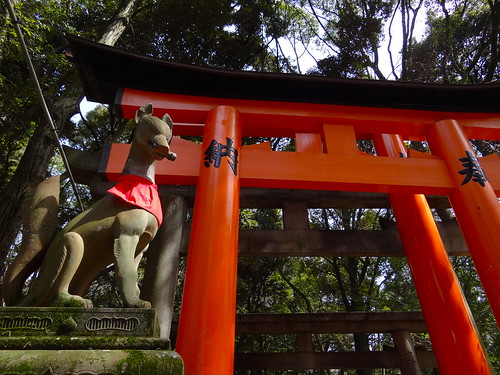 is for jinja, or the Japanese word for shrine. Kyoto has literally hundreds of shrines within the city limits, but today I want to talk about one of the most famous (and voted #1 attraction in all of Japan last year): Fushimi Inari Shrine. Fushimi Inari is one of the most famous and recognizable shrines in all of Japan. Well-known for its long tunnels of torii gates, a red and black wooden archway that symbolizes one’s passage from the mundane to the profound. All of the gates at Inari Shrine have been donated by businesses (the cheapest price for a gate is around $2,500US!) and have been engraved with the business’s information.
is for jinja, or the Japanese word for shrine. Kyoto has literally hundreds of shrines within the city limits, but today I want to talk about one of the most famous (and voted #1 attraction in all of Japan last year): Fushimi Inari Shrine. Fushimi Inari is one of the most famous and recognizable shrines in all of Japan. Well-known for its long tunnels of torii gates, a red and black wooden archway that symbolizes one’s passage from the mundane to the profound. All of the gates at Inari Shrine have been donated by businesses (the cheapest price for a gate is around $2,500US!) and have been engraved with the business’s information.
The shrine itself is dedicated to the god/goddess Inari, who is the god of five different dominions (fertility, rice, industry, agriculture and foxes). Inari has no predetermined sex, and can be portrayed as male, female or androgynous. Inari’s messengers to the mortal world are white foxes, which are often depicted carrying either a key or a wish-fulfilling jewel. They are often decorated with votive red bibs out of respect by worshipers.
The shrine is also one of the oldest in Japan, dating back to the late 900s with Emperor Murakami. It is a beautiful shrine nestled at the foot of Inari Mountain in southern Kyoto, with many smaller shrines connected to it through the dozens of arch-filled walkways further up the mountain. It can easily take up to two hours to explore the whole area. Highly recommended, with plenty of reasons to visit it more than once. I’m really going to miss the red-orange of Kyoto’s shrines.
Images hosted on Flickr.









27 responses to “S is for 神社”
Beautiful photos. I’ve seen the red and black arches on TV before, but I never knew their significance.
Tasha
Tasha’s Thinkings | Wittegen Press | FB3X (AC)
LikeLike
Absolutely gorgeous, Alex. I love the arches, but I think my favorite photo is the last one, the little pool with the frog statue. Is there a particular purpose for that pool? And what are those hammer-like objects there, too?
LikeLike
The “hammers” are actually little ladles which you dip into the water and pour over your hands. It’s part of a cleansing process when you visit a shrine.
Back on topic, I’m planning to visit Fushimi Inari when I come to Kyoto during Golden Week. I’m really looking forward to seeing it for myself!
LikeLiked by 2 people
You’ll love it there! And thanks for answering her question. ☺
I need to go back there. But, woo! During Golden Week is going to be so busy!
LikeLike
I know, but I expect to arrive right at the end – Wednesday or Thursday. Hopefully by then the worst crowds will have trailed away.
LikeLike
Ladles! *facepalm* You know, I knew “hammer” wasn’t the right word, and the other one was on the tip of my tongue… But I just couldn’t remember it. *embarrassed*
Thanks for clarifying!
LikeLiked by 1 person
You’re welcome. And to be honest, a shrine which puts little hammers by a pool at it’s entrance is just as intriguing…
LikeLiked by 2 people
Such beauty to surround yourself with – what is the significance of the red bib?
LikeLike
Beautiful. It must be lovely to walk through that orange glow.
LikeLike
It is beautiful. You take such wonderful pictures.
LikeLiked by 1 person
I love foxes so much…
LikeLiked by 1 person
Didn’t get to go here when I was in Kyoto! 😦 Oh well, next time! Great photos!
LikeLiked by 1 person
Beautiful shrine. I loved reading about Inari 🙂
LikeLiked by 1 person
That’s such a beautiful shrine and yesterday night I saw this shrine on a photo shared by Nat Geo on Instagram. That moment I thought of you and today this is on your blog. How awesome! 🙂
Loved your post Alex!
LikeLiked by 1 person
Definitely a case of serendipity! 🙂
LikeLike
It so striking!
LikeLiked by 1 person
Stunning photos. What an incredible place.
LikeLiked by 1 person
I suppose kids never play chase or tag in and among those gates, do they?
That’s what they make me want to do.
LikeLiked by 1 person
Haha. I did see some kids running through them before. Japan is pretty relaxed about where kids play. 🙂
LikeLike
Really interesting post, Alex. And great pictures!
LikeLiked by 1 person
That iconic red-orange color is so stunning. Enjoy it while you can 🙂
LikeLiked by 1 person
I promise I will! I love shrines. 🙂
LikeLiked by 1 person
So beautiful. Sounds like a must see if ever in Japan.
~Patricia Lynne aka Patricia Josephine~
Member of C. Lee’s Muffin Commando Squad
Story Dam
Patricia Lynne, Indie Author
LikeLike
Pretty amazing shrine and I bet it is just gorgeous right now – have the cherry blossoms dropped their flowers?
@Door2LoreSue
PowerofStoryBlog – Every Hero Has a Story
LikeLike
Yes, unfortunately. 😦 Cherry blossom season only lasted three days this year! Too much rain.
LikeLike
I love that colour, like a beautiful blazing sunset. I recognized Inari because she shows up in Kevin Hearne’s Iron Druid series. The things I learn from fiction! 🙂
LikeLiked by 1 person
[…] Q is for 観音 (18 comments vs. 12 last year) R is for ラリー (21 comments vs. 20 last year) S is for 神社 (26 comments vs. 14 last year) T is for 寺 (32 comments vs. 19 last year) U is for 宇治 (29 […]
LikeLike